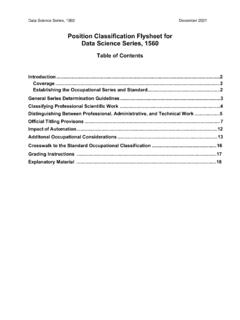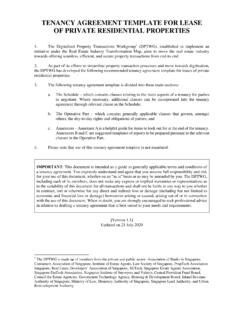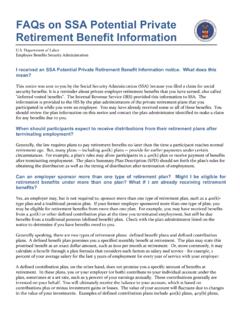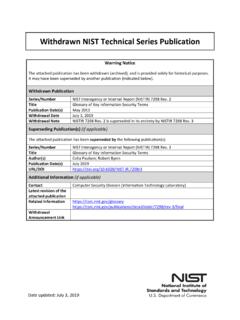Transcription of 2021 Guide to Telework and Remote Work in the Federal ...
1 U nited StateS O ffice Of PerSOnnel M anageMent 2021 Guide to Telework and Remote Work in the Federal Government Leveraging Telework and Remote Work in the Federal Government to Better Meet Our Human Capital Needs and Improve Mission Delivery NOVEMBER 2021. Introduction and Background Telework : Benefiting Employer and Employee Alike Telework has existed in the Federal Government for many years. At least since the Telework Enhancement Act of 2010 (Public Law 111-292) became law, executive branch departments and agencies ( agencies ) have demonstrated that Telework is an efficient and effective way of working to deliver on agency missions.
2 Never has the importance of a robust Telework program been more apparent than during the COVID-19 pandemic. The COVID-19 pandemic forced even more adoption of Telework and sparked a nationwide focus on Telework as an important tool for safely and efficiently delivering mission-critical services in the public and private sectors during both short- and long-term emergencies. We know the benefits of Telework for organizations and employers. A robust and well-practiced Telework program improves employee performance and engagement and supports mission productivity and efficiency. Telework can serve as a critical workplace flexibility that enables agencies to meet mission-critical needs of the organization.
3 And it can help Federal workers balance work and personal responsibilities and make use of beneficial work environments, thereby enhancing employee satisfaction and wellbeing, aiding retention, and serving as a draw to potential applicants. We also have an imperative to plan for a variety of contingencies, be them severe weather events, public health emergencies, and more. It's critical that the Federal government and our workforce remain flexible, resilient, and ready to continue our critical work on behalf of the American public, no matter the challenge. And as we saw during the past twenty months, never was the need for this increased flexibility and resiliency more important.
4 The COVID-19 Pandemic Has Transformed the Federal Workplace As We Know It The COVID-19 pandemic forced changes to the workplace. Many employees learned how to perform the functions of their job in a new way during a difficult time, meeting the challenges head-on. agencies demonstrated that they have been able to carry out their missions effectively. Accordingly, agencies now have an opportunity to revisit how they were operating prior to the pandemic and leverage lessons learned during the pandemic to integrate Telework and Remote work into their strategic workforce plans. As we look to the future, OPM is encouraging agencies to strategically leverage workplace flexibilities such as Telework , Remote work, and alternative/flexible work schedules as tools to help attract, recruit, and retain the best possible workforce.
5 Updated Guidance for Federal agencies In response to growing interest in Telework and Remote work, OPM is issuing supplemental policy guidance to provide agencies with practical resources and information to assist them in evaluating how to leverage these tools to meet mission-critical needs for organizations and balance the needs of a changing workforce at the same time. While this updated guidance focuses on assisting agencies in updating their current policies, we expect to continue our examination of Telework and Remote work policies over the coming years as agency operations evolve, and as the Federal Government further defines a broad vision for the Future of Work.
6 The Federal Government, as the nation's largest employer, is well-positioned to leverage Telework , Remote work, and other workplace flexibilities to adapt to the changing needs of the workforce of the future. OPM is excited to help lead the way in modernizing the way the Federal government does business to best serve the American people. How To Use This Guide This 2021 Guide to Telework and Remote Work in the Federal Government is designed to replace the contents of OPM's 2011 Guide to Telework in the Federal Government. This new Guide offers resources to help contextualize the continued evolution of Telework and Remote work as critical workplace flexibilities given the increased adoption of these flexibilities as a result of the COVID-19 pandemic.
7 This Guide is composed of two distinct parts that cover: Part 1 Technical Guide on Telework : An overview of Telework arrangements, laws, agency roles and responsibilities, and guidance to develop agency Telework policies Part 2 Technical Guide on Remote Work: A review of implications, considerations, and strategies for the appropriate use of Remote work arrangements Though presented separately, these two parts may be used in conjunction with one another as an interdependent resource intended to provide comprehensive flexible workplace guidance for Federal agencies , Telework Managing Officers (TMOs), Telework program coordinators, managers, supervisors, and employees.
8 When deployed effectively, Telework and Remote work can work in tandem to help agencies achieve their goals. 2. Part 1 Technical Guide on Telework Contents Introduction and 1. Telework : Benefiting Employer and Employee Alike .. 1. The COVID-19 Pandemic Has Transformed the Federal Workplace As We Know It .. 1. Updated Guidance for Federal agencies .. 2. How To Use This Guide .. 2. Part 1 - Technical Guide on Telework : An Overview of Telework Arrangements, Laws, Agency Roles and Responsibilities, and Guidance to Develop Agency Telework 6. Legislative Background .. 7. Agency Roles and Responsibilities under the Act.
9 7. What is Telework ? .. 10. Definition of Telework .. 10. Key Terms .. 10. Types of Telework Arrangements .. 11. Telework Arrangements: Routine vs. Situational Telework .. 12. Comparison of routine Telework and situational Telework : .. 12. Telework Fundamentals .. 13. Telework Policy Development .. 15. Telework 19. Notify Staff of Telework Eligibility .. 20. Ineligibility Under the Act .. 20. Training .. 21. Telework Agreements .. 22. Telework Agreement Contents .. 22. Terminating a Telework Agreement .. 23. Telework Managing Officer (TMO) .. 24. Reporting .. 25. Additional Guidance.
10 27. Continuity of Operations .. 27. Evacuation Pay Authority .. 27. Governmentwide Dismissal and Closure Procedures .. 28. Agency Responsibilities .. 28. 3. Part 1 Technical Guide on Telework Manager Responsibilities .. 29. Teleworker Responsibilities .. 29. Telework and Pandemic Emergencies .. 29. Information Systems and Continuity of Operations .. 30. Pay, Leave, and Work Schedule Flexibilities .. 31. Official Worksite and Pay .. 31. Pay During Temporary Full-time Telework Arrangements .. 32. Premium Pay .. 33. Leave and Work Scheduling Flexibilities .. 34. Weather and Safety 34.









